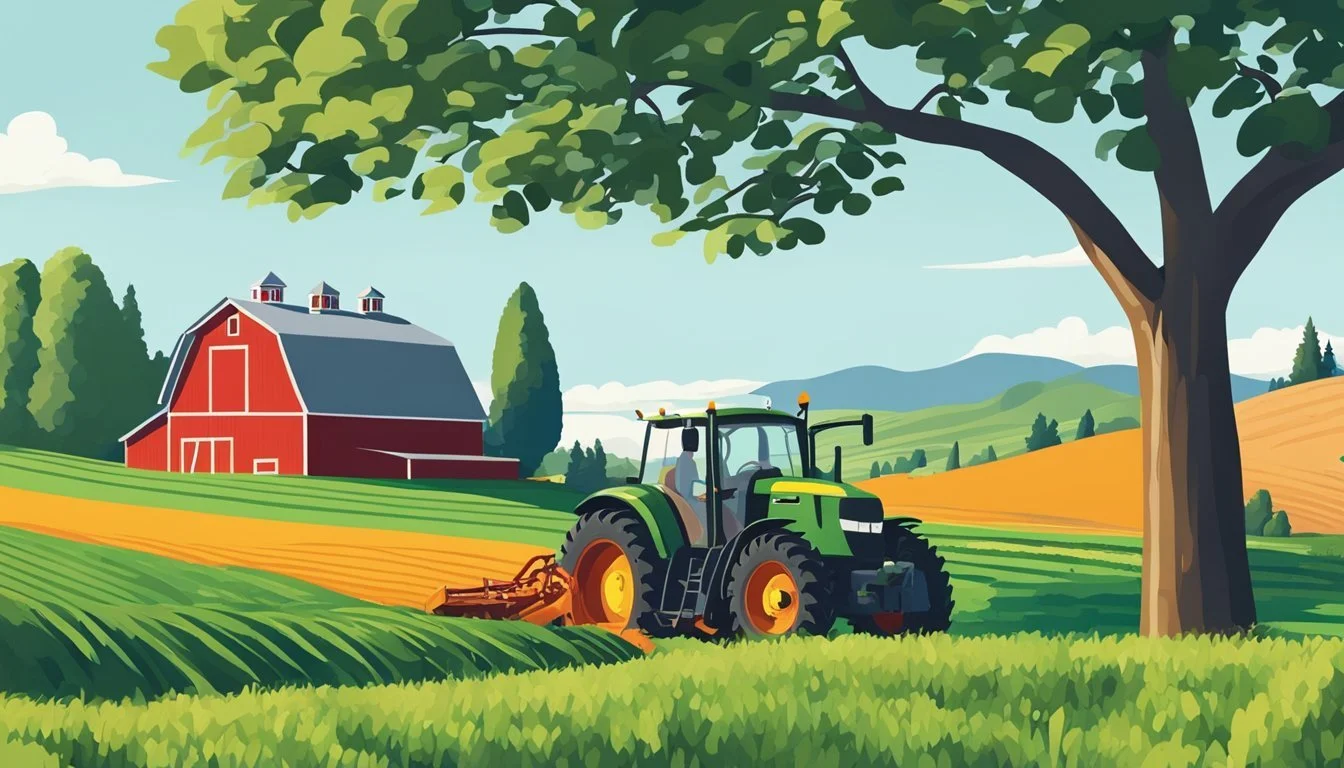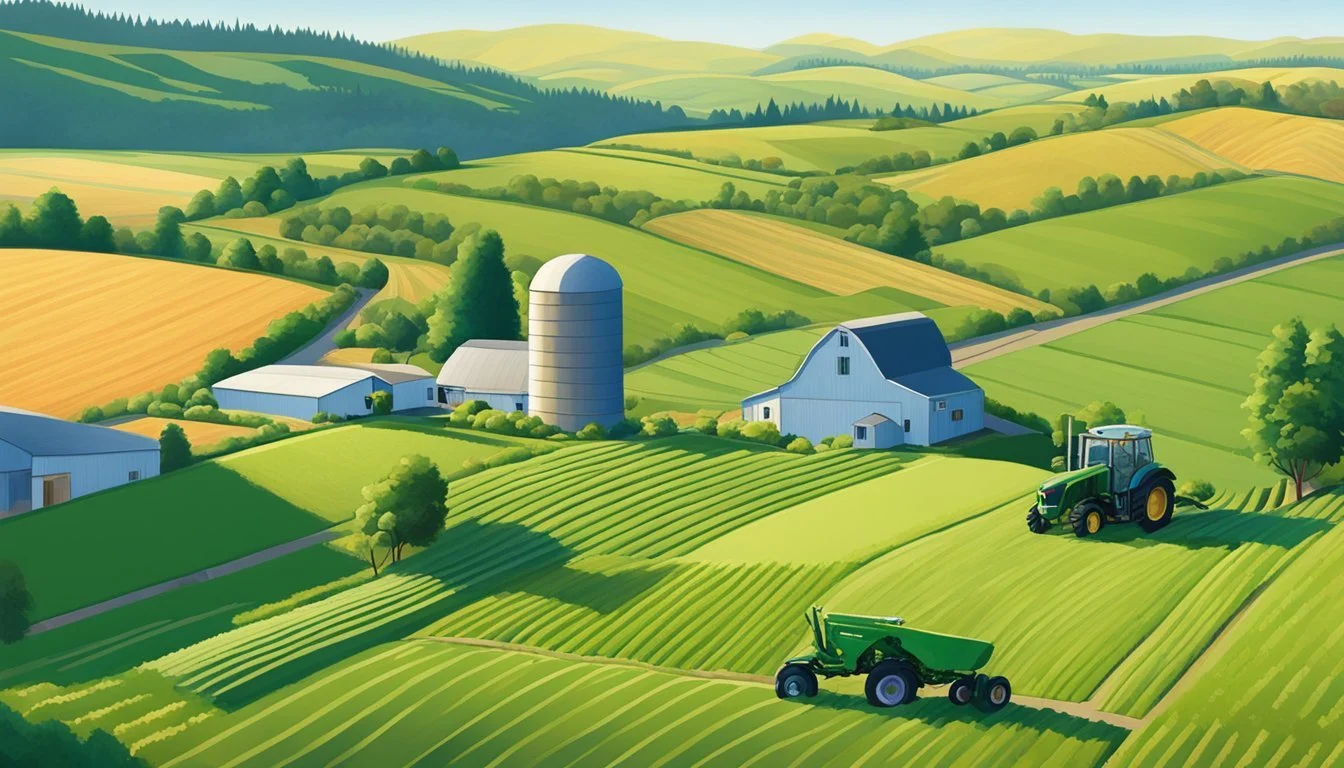Farm Loans in Oregon
Navigating Your Options for Agricultural Financing
This Article is Part of Our Guide on Farm Loans for All 50 U.S. States
Farm loans play a crucial role in supporting Oregon's agricultural community, addressing the financial needs of farmers and ranchers to spur growth and sustainability. Within the state, a variety of loan programs are available that cater to different facets of agricultural operations. These programs range from assisting beginning farmers in establishing their businesses to offering financial support for operational costs and farm expansion for established producers.
Oregon's farms and ranches benefit from access to both federal and state loan programs, with several options tailored specifically to regional needs. The Farm Service Agency (FSA) provides direct and guaranteed loans for newcomers to the industry who may find it challenging to secure commercial credit. This targeted financial assistance is fundamental, as it ensures the continued vitality and regeneration of the agricultural sector.
Financial institutions in Oregon, including some private lenders, are instrumental in facilitating the flow of credit through loans and loan guarantees. The USDA Farm Service Agency, with its presence in Oregon, serves as a federal pillar in the agricultural community, persistently working to help farmers and ranchers feed the nation and the world. As of recent data, entities such as Farm Credit Oregon signal a substantial involvement in the state's agricultural credit market, emphasizing their commitment through customer dividends and a formidable loan volume.
Understanding Farm Loans in Oregon
Farm loans in Oregon offer vital support for establishing and maintaining agricultural operations. They are especially critical for beginning farmers who may have difficulty securing commercial credit.
Role of the Farm Service Agency (FSA)
The Farm Service Agency (FSA), a branch of the United States Department of Agriculture (USDA), plays a crucial role in providing financial assistance to farmers and ranchers. In Oregon, the FSA delivers various loan programs targeting those who are unable to procure financing through traditional commercial channels.
Types of Loans Available
There are several types of loans available to Oregon farmers through the FSA:
Operating Loans (OL): To cover operating costs like feed, seed, equipment, and living expenses, subject to a maximum of $300,000.
Farm Ownership Loans (FO): These help farmers purchase or expand a farm, and there's a special Direct Down Payment variant aimed at helping beginning farmers.
Microloans: These smaller, more accessible loans support non-traditional farm operations and niche markets.
Emergency Loans: Offered to farmers who have suffered losses due to disaster.
Each type of loan serves a different need, ensuring a tailor-fit solution for varied agricultural requirements.
Eligibility Requirements for Borrowers
Prospective borrowers must meet certain eligibility criteria to qualify for FSA loans:
Credit Requirements: A satisfactory history of fulfilling credit obligations.
Beginning Farmers: Special emphasis given to novice farmers, including targeted funds.
Experience: Demonstrable experience in managing or working on a farm.
Other conditions may include the formulation of a business plan, which is strongly recommended to guide the successful use of the loan.
Types of Farm Loans
Farm loans in Oregon offer essential financial support for various operational and ownership needs across the agricultural industry. They can be tailored to assist with crop and livestock expenses, land acquisition, and urgent needs due to unforeseen circumstances.
Operating Loans
Operating loans provide farmers with the necessary capital to cover day-to-day expenses such as seed, feed, equipment maintenance, and other operational costs. These loans are crucial for maintaining regular farm activities. The USDA's Farm Service Agency (FSA) offers Direct Operating Loans and Guaranteed Operating Loans to cater to these needs.
Farm Ownership Loans
Farm Ownership Loans are intended for farmers and ranchers looking to purchase or expand their farm real estate. These loans can cover both the purchase of property and the costs associated with improving and repairing existing farm facilities. The USDA FSA offers both Direct Farm Ownership Loans and Guaranteed Farm Ownership Loans depending on applicants' needs.
Microloans
The FSA's Microloan program targets the unique financial needs of small farm operations, beginning farmers, and ranchers. These loans provide a maximum of $50,000 and can be used for all aspects of farm management, including tools and equipment, livestock, and initial start-up costs.
Youth Loans
Youth Loans are designed specifically for young individuals involved in organizations such as FFA or 4-H clubs. These loans help to fund educational agricultural projects which can cover livestock, equipment, and supply costs. The aim is to cultivate responsibility and expose the youth to agricultural business practices.
Emergency and Disaster Loans
Emergency and Disaster Loans are available for farmers who have been hit by natural disasters and have subsequently incurred substantial financial losses. The FSA can provide loans up to $500,000 for farmers in designated disaster areas to help them recover and rebuild their farming operations. These loans are underpinned by the RMA's (Risk Management Agency) guidelines and help ensure agricultural stability in the region.
Applying for Farm Loans
When seeking farm loans in Oregon, applicants should be prepared with a detailed business plan, understand available government resources, and be well-informed about loan terms and repayment conditions.
Preparing Your Application
Before applying for a farm loan, it's crucial to have a comprehensive business plan. This plan should outline objectives, strategies, a market analysis, and detailed financial projections. Loan information should include the amount of capital needed and its intended use. Prospective borrowers must document their ability to manage farm operating costs and family living expenses, as well as their readiness for potential closing costs associated with the loan.
Navigating Government Resources
Applicants can explore government loan options through resources like farmers.gov which houses tools such as the Loan Assistance Tool and the Farm Loan Discovery Tool. These online tools guide users through the variety of available farm loans, helping to match their specific needs with appropriate financing options. The Farm Service Agency (FSA) provides direct and guaranteed loans especially aimed at beginning farmers and ranchers who may struggle to secure commercial credit.
Understanding Loan Terms and Repayment
Clear comprehension of the terms of a farm loan is fundamental. Interest rates, repayment schedules, and collateral requirements—each has a significant impact on the overall cost of the loan. Prospective borrowers should investigate these terms carefully and consider how they align with the farm's cash flow projections. Loans can often be used to not only purchase livestock and equipment but also cover critical operating costs, ensuring the farm remains productive during lean periods.
Resources for Oregon Farmers
Oregon farmers have access to a range of resources aimed at supporting their agribusinesses through technical guidance, risk management, and funding opportunities.
Technical and Educational Assistance
Oregon's agricultural sector benefits from technical support and educational programs designed to enhance the productivity and sustainability of farming practices. Entities like the OSU Extension Small Farms Program provide invaluable assistance to farmers, offering expertise on a variety of agricultural topics. Technical resources include agronomy, livestock management, and soil health, while educational projects often encompass workshops, webinars, and field days focused on the latest agricultural research and methodologies.
Technical Assistance Providers:
OSU Extension Small Farms Program
Niche Meat Processors Assistance Network
Organic Extension Program
Insurance and Risk Management
To protect against financial risks, Oregon farmers have access to crop insurance programs like the Agriculture Risk Coverage (ARC) and Price Loss Coverage (PLC) programs. These are crucial for mitigating the impacts of fluctuating market prices and crop revenue issues. The USDA Farm Service Agency also offers programs addressing non-insured crop disasters (NAP), providing a safety net for producers facing losses due to natural adversities.
Key Risk Management Programs:
Agriculture Risk Coverage (ARC)
Price Loss Coverage (PLC)
Non-Insured Crop Disaster Assistance Program (NAP)
Grant and Funding Options
Grants and loans serve as crucial funding mechanisms for Oregon farmers looking to start or expand their operations. While grants are less common for initiating farms, the state provides loan options through the USDA Farm Service Agency's loan and micro-loan offerings. These loans can be instrumental in covering an array of farm needs, from purchasing land to upgrading equipment.
Funding Resources:
Farm Plus Financial: Farm loans provider
USDA Farm Service Agency: Loans, micro-loans
Oregon's agricultural support framework offers diverse avenues for ranchers and farmers to secure financial stability and advance their farming practices.
Specialty Farming in Oregon
Specialty farming in Oregon contributes significantly to the state’s agricultural output, embracing a diverse range of crops known for their economic value. This section provides insight into the realms of specialty crop production and the growing interest in alternatives to traditional farming.
Specialty Crop Production
Oregon specializes in a variety of crops that are recognized for their quality and economic contribution to the state's agricultural sector. Among these, hops and pears stand as key commodities, with Oregon's climate and soil conditions favoring their cultivation. The state is also a notable producer of Christmas trees, and sweet corn, exhibiting a thriving seasonal market domestically and internationally.
Blackberries: (how long do blackberries last?) Alongside these, Oregon's blackberry production is substantial, encompassing several varieties that thrive in the Pacific Northwest climate.
Microloans: To support the growth of these crops, small and beginning farmers often utilize microloans, which are crafted to meet the needs of non-traditional and specialty operations.
The Oregon Department of Agriculture has initiatives such as the Specialty Crop Block Grant, which aim to enhance the competitiveness of these crops.
Alternatives to Traditional Farming
In response to market demands and environmental considerations, Oregon's farmers are increasingly turning to non-traditional and specialty operations. These include innovative approaches such as:
Sustainable Practices: Emphasizing eco-friendly methods to enhance soil health and reduce carbon footprint.
Diversification: Incorporating a mix of specialty crops to mitigate risks and capitalize on niche markets.
Farmers in Oregon are exploring diverse crops and practices, recognizing the importance of sustainability and innovation in specialty farming. Support in the form of technical assistance and financial incentives is available to encourage such transitions.
Additional Farm Loan Programs
Farmers in Oregon looking for financial support have access to a variety of additional farm loan programs geared towards conservation efforts and livestock-related activities. These programs offer financial relief and resources to ensure agricultural practices are sustainable, environmentally friendly, and profitable.
Conservation and Environmental Programs
The Conservation Reserve Enhancement Program (CREP) forms a pivotal part of the conservation and environmental initiatives. It targets farmers who are willing to convert environmentally sensitive agricultural land into conservation reserves. Key components of CREP include:
Soil Health: Encouraging practices that improve soil quality and prevent erosion.
Water Resources: Aimed at protecting and conserving water sources on agricultural land.
Livestock and Commodity Programs
For livestock farmers, the Emergency Assistance for Livestock, Honeybees and Farm-Raised Fish Program (ELAP) provides crucial financial aid following natural disasters. ELAP specifics include support for:
Livestock Indemnity Program
Honeybee populations
Farm-raised fish losses
Additionally, the Agriculture Risk Coverage (ARC) and Price Loss Coverage (PLC) programs are designed to protect farmers from the unpredictable nature of crop commodities, offering coverage for products including milk, berries, and cherries. These funds act as a safety net against sudden market fluctuations.
Local Oregon Agriculture Support
Oregon offers robust support for the agricultural sector, focusing on community networks that aid farmers and ranchers, and diverse financing options through both government and non-governmental entities.
Community Organizations and Networks
In Oregon, Adelante Mujeres and 4-H Clubs play pivotal roles in strengthening local agriculture. Adelante Mujeres provides education and empowerment to low-income Latina women and their families to foster full participation in the local economy. This includes support for female farmers to grow and sell organic produce. Meanwhile, 4-H Clubs are deeply involved in agricultural education for the youth, encouraging future generations to take up farming.
Oregon's Department of Agriculture collaborates with these organizations to provide resources and support, reinforcing the state's agricultural framework and ensuring small and new farms thrive alongside larger operations.
Financing through Non-Governmental Entities
For financing, farmers have various options beyond government programs. Farm Credit services offer significant support to Oregon farmers. These cooperatives provide loans and financial advice to their members. Additionally, local credit unions often have tailored loan products for the agricultural sector.
Business Oregon, part of the state's economic development department, extends its hand in helping small farms and agricultural businesses by facilitating access to different financing options. The Small Business Administration (SBA) also provides loans that can be used for agricultural purposes, and while not directly farming-centric, their services are a crucial piece of the financing puzzle for small-scale Oregon agricultural businesses.
Government-backed FSA loans and guaranteed loans are avenues for credit that also support Oregon's agricultural community. These loans provide capital for those unable to secure commercial credit, ensuring that beginning farmers and established operations have the resources they need for sustainability and growth.
Infrastructure and Storage
In Oregon, farmers have access to resources that help them improve the effectiveness of their farm's infrastructure and storage. These upgrades play a critical role in enhancing agricultural productivity and managing operating costs.
Farm Storage Facilities
The Farm Storage Facility Loan (FSFL) program aids producers in storing, handling, and/or transporting their commodities. Specifically, this loan caters to the following needs:
Construction: The building of new storage facilities such as silos, grain bins, and hay sheds.
Upgrades: Enhancing existing storage and handling structures.
Equipment: Funding for items such as cold storage, safety upgrades, and handling equipment.
The loans are tailored to increase the ability to market commodities for the producer, thereby ensuring that the supply chain is efficient and capable of meeting demand.
Investing in Agriculture Infrastructure
Investing in agricultural infrastructure transcends just storage:
Energy Efficiency: Implementation of renewable energy sources and energy-efficient storage solutions to reduce operating costs.
Modernization: Adoption of new technologies to improve storage facilities, which can range from better ventilation systems to advanced monitoring equipment.
Each investment in infrastructure often entails an assessment of long-term returns and sustainability. This includes not just the financial outlay but also considering the environmental and economic impact on the farm and the surrounding community.










